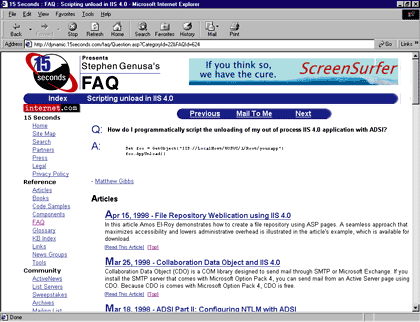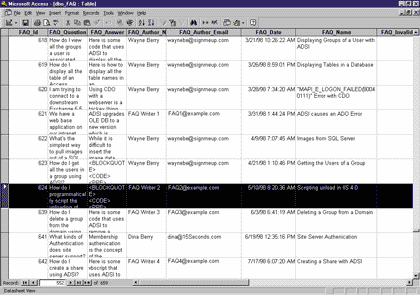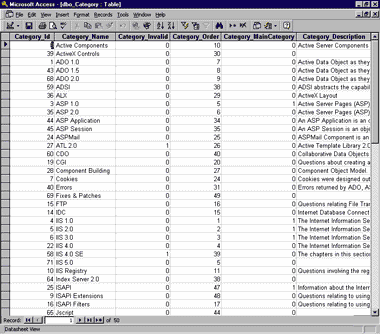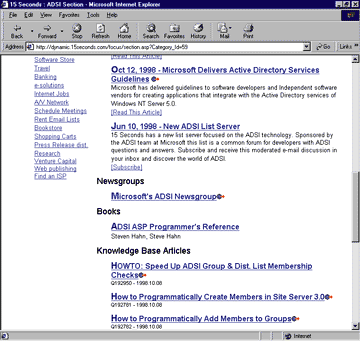![]()
This article assumes you're familiar with Active Server Pages
|
This article may contain URLs that were valid when originally published, but now link to sites or pages that no longer exist. To maintain the flow of the article, we've left these URLs in the text, but disabled the links.
|
| The proprietor of one of the most prominent ASP community sites explains the design trade-offs involved in a successful development portal. |
A Little History
15 Seconds started when I tried to reply to a question posted on a list server about isapi, the foundation for the ASP technology. My email answer was basically everything I knew at that time about ODBC technology. The answer was so long that the list server rejected the response, so I decided to post it on a Web site instead. The comments from people reading that article made me realize that there was a need for more information about the first version of IIS (which was still in beta at that time). Thus, 15 Seconds was born, transforming me from a programmer to a publisher, a role that I would not understand fully until a few years later.
The name comes from the fact that 15 seconds is the average amount of time a user will wait for a Web page to return. In the beginning, all the articles were about performance, which was a big issue with isapi and the first versions of ASP.
I was not really suited for the role of publisher. I received average grades in English through college, and when I started 15 Seconds I had no knowledge of style or many other basic publishing concepts. I did know something about database design and programming. I also knew that I didn't want to format all the articles that I wanted to publish on 15 Seconds. So I designed a database to hold the articles, decided on an article format, conceived a way to list the articles, and designed an isapi DLL to run my publishing system. The principle behind this system has remained the same since the beginning: separate the content itself from the format of the content. Though the format of the Web site has changed, and the technology has evolved (isapi to IDC to ASP), this concept has not. In this article I will discuss how I applied this concept to the development of 15 Seconds.
Limitations
The size of a Web site is limited by its design. Designing your site from the beginning to handle future growth can save you a lot of time in the long run.
At first, most site designers do not have the content to create a large Web site, so they start with a navigation design that will only support a small site. Most of the time they begin by programming their site by hand or using an editing tool such as Microsoft FrontPage®. As more articles are published or additional content is added, the Web designer needs to expand the navigation to make all the articles reachable, while providing the reader with a consistent experience. To get the most traffic from your articles, you need to cross-link them and provide alternative means to reach them. This means that for every article written, old articles need to be adjusted to link to the new article.
At some point, publishing a new article requires more work formatting and linking to the article than it does writing the article. This is the opposite of the design's purpose, and only gets worse as the site grows. In my experience, one person working on a site 40 hours a week can't publish and maintain a site of over 200 pages using only static HTML. You can add extra people to the team, but this is not a solution—it is a workaround. Site owners who can't overcome this problem either get sloppy with their design, start to toss old articles (otherwise known as archiving), or adopt a database design.
Database Publishing
Database publishing is a development technique for Web sites in which the content is stored in a database and is inserted into HTML by the Web server. When a request is made to the Web server from the browser, the address usually refers to a template and a query string that tells the server how to populate the template. The Web server then loads the template, calls the database to get the content, fills the template, and sends the HTML back to the browser. The template is usually written in a language like Perl, CGI, ASP, or Cold
Fusion. When written in one of these languages, the Web server executes this code, which calls the database and fills in the template.
On the 15 Seconds Web site, all the templates are written in ASP 2.0 and call SQL Server 7.0. The templates can be classified in two ways: leaf templates or list templates. List pages are lists of links to leaf pages. Leaf pages display one row from a table and link to other leaf pages related to the row that you are reading. For example, a leaf page could display a question and an answer to a FAQ. A list page will list all the FAQs in a specific category.
 |
| Figure 1: A FAQ on the 15 Seconds Site |
|
Templates eliminate inconsistencies in formatting the HTML content of individual pages. Since each row in the table is formatted with the same template, each page comes out identically. On 15 Seconds, I have one table called FAQ. Each row in the table is an individual question; columns represent the question, the answer, and the person who answered the question. Since I have one leaf template called question.asp that displays every FAQ in the table, I have 700 pages that appear identically (see Figure 1).
To add a frequently asked question to the site, all I have to do is add a row to the FAQ table. That page can then be generated by calling the question.asp template with the primary key of the row. The FAQ_Id column in the FAQ table is an auto-incrementing identity. Each time I add a row, a unique number is inserted by the database in the FAQ_Id column. This number is referred to in the query string when the question.asp template is called (see Figure 2). |
 |
| Figure 2: Adding a Question to the FAQ Table |
|
When adding additional content to the 15 Seconds site, all I have to do is create additional tables that
represent that content and create a template that formats the content. For example, I created a Book table (see Figure 3) and a book.asp template for book reviews, and a KB table and a kb.asp template for Knowledge Base articles. Once I had a system for creating leaf pages, all I had to do was link up those pages so that the user could find them. |
 |
| Figure 3: The Book Table |
|
Broken Links
Database publishing eliminates a lot of broken links that can be created when you program your Web site with just static HTML. One of the ways to avoid broken links is to make the template create the list of links. When I first started 15 Seconds, I used a simple query to generate a list of all the FAQs from the FAQ table (see Figure 4). All I had to do was query the rows and create a link to the faq.asp leaf template using the primary key of the table as the reference for the FAQ to display. If I added a row to the FAQ table, not only would I get a new page from the faq.asp template, I would get another link in the link's page. If I removed a row, the link would be removed from the link's page. |
 |
| Figure 4: A List of all FAQs |
|
At first, I didn't have many FAQs so I was able to list them all in a single page. As the number of rows in the FAQ table grew, the links page grew as well. With a lot of links in the page, readers were having a hard time finding the answers to their questions. Now they're divided into categories, so the reader can pick the category he wants before being presented with the list of links.
Organizing and Exploiting the Categories
|
 |
| Figure 5: The Category Table |
|
I created a many-to-one relationship between the categories and the FAQ with a CategoryFAQ table that held the primary key for the category and the primary key for the FAQ. This way, I could put the same FAQ in many categories. The FAQ might be about ActiveX Data Objects (ADO), but it might also belong in the Just Beginning category.
I also divided the books, articles, Knowledge Base links, and other content into separate categories by creating more many-to-one relationships with tables like CategoryBook and CategoryIssue. Once I'd made these relationships, adding content to the site was a two-part process. You can add the row to the appropriate table, such as the FAQ table, and then add a row to the many-to-one relationship table, like CategoryFAQ. After you have done the work of getting relationships in place, you can do some very powerful things with the database. One way that you can exploit your new relationships is by cross-promotion of other content within a leaf page. For example, if the user is reading a FAQ about ADO, they might want to know about articles, books, and Knowledge Base documents regarding ADO. In your leaf page, you can easily determine which categories relate to the FAQ they are reading and display the other content that might interest them. This technique creates additional layers of navigation, including one between leaf pages. If the user has drilled down to a particular topic, it is more likely that they will want to stay in that topic rather than go back up the tree and to another topic. So linking related list pages gives the user an easier time navigating the tree of information. One way to think about it is as branches of information. |
 |
| Figure 6: The ADSI Focus Section |
|
Another way to use the category relationships is to link to all leaves in a category branch. These are called focus sections on the 15 Seconds site, and they're on the top level (see Figure 6). They are lists of all articles, books, offsite links, and Knowledge Base links in a particular category. If a reader wants to see everything 15 Seconds has on Site Server, she can call the focus section page.
This technique provides for an additional method of navigation that follows human nature, not the database. In other words, readers can now navigate by category instead of by content type.
Bumps in the Road
XBuilder
Summary
|
|
|
|
http://msdn.microsoft.com/workshop/ design/layout/site021599.asp and http://msdn.microsoft.com/library/devprods/ vs6/vinterdev/vidref/viovrdesigningsites.htm |
|
From the November 1999 issue of Microsoft Internet Developer.
|